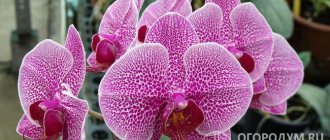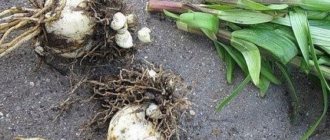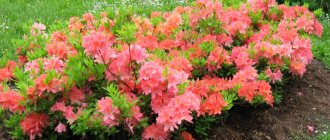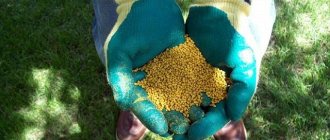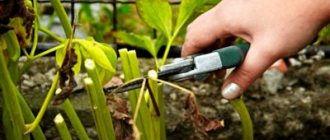The magnificent azalea came to us from India and China, where in its natural form it decorates the mountain slopes with a dense, multi-colored carpet. The flower, not too demanding to care for, found its application in the art of bonsai and became a real Christmas miracle for residents of other countries. Azalea blooms in winter, from December to March, when there is snow and frost outside, and a brightly colored window sill gives warmth and comfort. To remain healthy and delight with the abundance of colors, the flower requires specialized fertilizer for azaleas, which must be applied to maintain color and restore during the rest period.
Why is it necessary to fertilize rhododendron at home?
Over time, the plant takes all the nutrients from the soil. Depletion of the soil leads to yellowing and falling of leaves and lack of flowering. The effect of fertilizers is due to the fact that they supply the plant with the necessary chemical components that promote normal growth, and also saturate the soil with mineral and organic substances.
Azaleas grow and develop only in acidic soil with a pH of 4.0-5.0 .
If you deviate from this value, the roots of the plant cannot absorb nutrients, which means the bush stops growing and developing. Normal pH levels are also achieved by applying fertilizers. Azalea is valued for its decorative properties, and a deficiency of any nutrient worsens its condition and appearance. The problem of lack of flowering or changes in the appearance of leaves is also easily solved with timely and correct fertilizing.
The main feeding of the bush is designed to bring the acidity of the soil to the desired level and saturate the plant with nutrients that promote growth. Auxiliary feeding serves to support the plant during the growing season, budding and flowering.
Azaleas have a shallow root system, so to apply fertilizer it is necessary to use methods that exclude digging up the soil.
How to take care of a plant?
What is fertilizing?
Fertilizing a plant is an event in which the grower introduces substances into the soil that ensure the growth, development, and flowering of the plant. These substances contain all the necessary micro- and macroelements that contribute to the best development of the plant. There are two types of fertilizers: mineral and organic.
Importance of the procedure
Like any other plant, feeding is very important for azaleas . Since the soil tends to deplete, plants take all the nutrients from it. They need to be replenished.
In this case, it is very important to pay attention to the season and the period of the life cycle (vegetation, flowering, dormancy). In each of these periods, the feeding schedule will be different, and the composition of fertilizers will also be different. How to feed an azalea so that it blooms?
Types of funds, their composition
Based on their origin, fertilizers are divided into the following.
Mineral
Simple
Increases the level of nitrogen (N), potassium (K) and phosphorus (P) in the soil:
- Nitrogen fertilizers promote the growth of branches and the development of foliage. The best choice for feeding azaleas would be Urea (carbamide). Contains 40-50% nitrogen, is highly soluble in water and contributes to soil acidification.
- Phosphorus fertilizers regulate plant metabolic processes and are a source of energy.
In acidic soil they become difficult for plants to reach, but do not affect the acidity of the soil. An effective supplier of phosphorus for azaleas is Phosphorite flour with a phosphorus content of 20-30%. When applied to the soil before planting and under the influence of soil acidity, it becomes accessible to azaleas and acts for several years. In the future, flour can be added to compost. - Potassium fertilizers increase resistance to diseases. Potassium sulfate contains 50% potassium and no chlorine, making it most suitable for azaleas. It is used both as a main and auxiliary fertilizer.
After flowering ends, nitrogen-containing fertilizers are applied; before buds appear and before flowering ends, fertilizers containing phosphorus and calcium are applied.
Complex
They are the most effective and easy to use, as they contain several nutrients. They are based on nitrogen, phosphorus and potassium compounds, magnesium salts, sulfur and a complex of trace elements. For example, Ammophos contains nitrogen and phosphorus, and Nitrophoska contains all three elements in correctly selected proportions.
Mineral fertilizers with a high content of sulfur and ammonium acidify the soil . Adding 30% ammonium sulfate to any complete mineral fertilizer forms an excellent fertilizer for azaleas. The preparation “Azalea” was specially developed as a ready-made complex fertilizer.
Do not use fertilizers containing chlorine!
Organic
- Cow dung .
0.5 kg must be filled with 5 liters of water and left for 3 days for fermentation. Then dilute 0.5 liters with 10 liters of water and water the plant. Pig and horse manure, as well as chicken manure, are not suitable for azaleas, as they increase the alkalinity of the soil. - Compost made from rotted grass and pine needles.
- Acidified water. Dissolve 1-2 tablespoons of citric acid in 10 liters of warm water. Use to increase acidity.
- Black tea . Its leaves contain calcium, magnesium, potassium, iron and other elements that help the development of the azalea's root system and promote its flowering. Pour 3 tablespoons of tea into 0.5 liters of boiling water. After cooling, drain. Dry the leaves and mix with soil when planting the plant (how to plant and replant an azalea?).
Before feeding the plant, it must be watered well.
How to feed a flower?
You can feed azalea with both mineral and organic fertilizers. These fertilizers differ from each other not only in composition, but also in their principle of action.
Organic matter
Organic substances are an environmentally friendly, balanced nutrition for plants that prefer acidic soils. Like any fertilizer, they ensure good flowering, healthy crown and roots.
Organic fertilizers improve:
- Soil structure.
- Water and air balance.
- Promote the development of symbiont fungi necessary for plant life.
A huge advantage of organic fertilizers is their safety in terms of overdose. They act gently and have a beneficial effect on the flower. As a rule, organic fertilizers contain products of both plant and animal origin.
May contain:
- manure;
- bird droppings;
- peat;
- compost, etc.
The components, decomposing in the soil, form minerals necessary for the prosperous life and development of the plant. In terms of efficiency, organic fertilizers are significantly superior to mineral ones; they have a longer but milder effect and tend to accumulate in the soil.
Mineral elements
Azaleas also need them at various stages of their life cycle. First of all, they are convenient and economical.
At the same time, mineral fertilizers provide:
- active flowering;
- intense coloration of the crown;
- healthy roots;
- fast rooting;
- good growth;
- health.
In addition, they can:
bring the plant out of dormancy;- increase resistance to diseases;
- strengthen the immune system.
But for greatest efficiency they need to be alternated with organic fertilizers. Mineral fertilizers contain:
- nitrogen;
- potassium;
- phosphorus;
- microelements;
- stimulants and other excipients.
Fertilizer application schedule in autumn, spring and other seasons
Indoor azaleas bloom in winter. It begins in November-January depending on the plant variety and lasts from 3 weeks to 2.5 months. To obtain a healthy plant and long flowering, you must adhere to the following feeding schedule:
- Spring – growth of green mass. Fertilizing with fertilizers containing nitrogen 2-4 times a month.
- Summer – saturation of the plant with phosphorus and potassium, organic fertilizers. Spraying with growth stimulants promotes the formation of a large number of buds. Frequency – 2-3 times a month.
- Autumn is the period of budding. Autumn feeding of rhododendrons is carried out 2-3 times a month with a complex with the addition of organic matter. Spray only on the leaves, avoiding contact with the buds (read about the rules for caring for rhododendron in the fall here).
- Winter is the flowering period. The azalea should be fed with complex fertilizers once a month. Do not spray.
We invite you to watch a video on how to properly fertilize azaleas in the spring:
How to suspect a nutrient deficiency in an azalea
Like other indoor plants, azalea has individual requirements for lighting conditions, soil, watering and additional nutrition. You can suspect a deficiency of a particular substance based on the following signs:
- The color of the leaf changes to something different from the usual;
- The plant stops growing and does not produce new shoots;
- The shade of twigs and new growth changes;
- The flowering period is reduced;
- Flowers fall off at the bud stage.
When it comes to fertilizer for azaleas, preference is given to nitrogenous fertilizers; it is this element that the plant most often lacks. With a lack of nitrogen, the leaves noticeably become smaller, turn yellow and even begin to fall off.
The problem may not only be with nitrogen, but also with other elements. Thus, with a lack of phosphorus, the shoots become noticeably thinner, the leaves first sharply darken and then acquire a red tint. With a deficiency of potassium, the leaves become covered with light spots, and without calcium, young leaves will not be able to grow, falling off even at the growth stage.
Features of feeding and care
Before the buds appear
- Particular attention should be paid to determining the acidity of the soil, bringing it to the required pH = 4.0-5.0. Use acidified water and add humus to the soil.
- To grow shoots and green mass, saturate the soil and plant with nitrogen.
- To prevent diseases, use Fitosporin according to the instructions (we talked in detail about the most common diseases and pests of azaleas in this article).
- During the budding period, add phosphorus and potassium to the nitrogen.
- Good results are obtained by fertilizing the plant with superphosphate at the rate of 15 g per 10 liters of water, as well as the preparations “Azalea”, “Kemira”, “Uniflon”.
During flowering
- Eliminate the supply of nitrogen.
- Do not spray plants.
- Continue saturating the azalea with phosphorus and potassium.
For the rhododendron to bloom
Growth stimulants, such as:
- "Zircon";
- "NV-101";
- "Ecogel-anti-stress";
- "Epin";
- succinic acid.
Spray the plants 2-4 times a month.
Read more about how to care for azaleas at home in a separate article.
Step-by-step instructions for depositing funds
The fertilizer complex is designed for long-term action and fully provides the azalea with all the necessary components.
Pokon
Long lasting fertilizer. Developed specifically for rhododendrons and includes all essential nutrients and trace elements. Available in granule form.
Composition of the drug:
- nitrogen (N) -19%, phosphorus (P) -5%, potassium (K) -23%;
- magnesium (MgO)-2%;
- sulfur oxide (SO3) -12%.
Application : Scatter the granules around the plant in the spring or when planting and dig in carefully without damaging the roots. Consumption – 10-30 g per plant, depending on its size. It is necessary to regularly water the bush to gradually dissolve the fertilizer. The big advantage is that a single application to the soil provides nutrition to the plant for 6-7 months.
Bona Forte
Complex fertilizer in liquid form. Contains all the substances necessary for azaleas, providing nutrition and strengthening the immune system of the bush. The content of microelements in chelated form promotes their absorption in full.
Composition of the drug:
- nitrogen (N)-9%, phosphorus (P2O5)-5%, potassium (K2O)-6%;
- magnesium (MgO)-1%;
- trace elements: boron, iron, manganese, zinc, copper, molybdenum, cobalt;
- vitamins B1, PP, C;
- succinic acid.
Application: Using root fertilizers together with spraying the leaves gives the best results. For irrigation, dilute 10 ml of solution in 3 liters of water, for spraying - 5 ml per 3 liters.
Fertilizing indoor azaleas:
- March-October: 1 time per week.
- November-February: 1 time per month.
Feed transplanted plants no earlier than after 10-15 days!
Can manure be used?
When planting, mix 1 part of cow dung or humus with 10 parts of soil. In the process of the beginning of the formation of buds, carry out a second feeding with the addition of phosphorus-potassium fertilizer.
succinic acid
A product of amber processing is an organic growth stimulant. It cannot replace fertilizers, but its use reduces the risk of diseases, accelerates the development of azaleas, and prolongs flowering.
Application: dissolve 1 g of succinic acid in 10 liters of water. The solution can be used for watering and spraying plants no more than once every 3-4 weeks.
What are the difficulties when growing and maintaining azaleas?
Pests and diseases of azaleas cause great damage to the shrub. The plant can become sick due to the following reasons:
- lack of moisture due to irregular watering;
- excessive exposure to sunlight;
- too high air temperatures in the room;
- improper placement of shrubs in the room;
- insufficient lighting;
- insufficiently nutritious soil.
- Wilting foliage. If the leaves turn yellow and fall off, then the problem is most likely due to a lack of moisture due to irregular watering, insufficient or excessive lighting. The problem is eliminated by following the rules of watering, lighting and spraying.
- Presence of rust or gray rot. These ailments can be eliminated by maintaining a comfortable temperature and trimming damaged leaves.
- Yellowing, wilting and falling of flowers. The reason in most cases lies in the use of low-quality water for irrigation. In this case, it should be done with boiled water with the addition of special fertilizers.
- Plant infection by late blight. This occurs when there is an excess of moisture in the soil, often leading to the death of the bush.
The main pests of azaleas are scale insects, spider mites and strawberry mites. They get rid of them using special means. The foliage can be treated with a soap solution and washed off with warm water. As a means to combat insects, you can take Actellik solution and spray the plant with it.
Errors and their consequences
Azalea does not tolerate an overdose of fertilizers, so it is necessary to strictly follow the instructions for using the drugs. Main mistakes and their consequences:
- If there is too much acid in the soil, the roots of the plant die.
- Oversaturation of a plant with nitrogen leads to abundant growth of green mass and lack of flowering.
- Spraying flowers leads to their death.
- Fertilizer containing chlorine will destroy the bush in a short time.
Rhododendron is a hybrid evergreen shrub. Another name is azalea. The plant is distinguished by its beauty and lush color. On our online portal you will find detailed instructions for caring for and replanting plants in the fall and after purchase, as well as learn about methods of propagation and pruning.
Preparations given at certain and correctly calculated periods make it possible to obtain a healthy plant with lush flowers.
Flowering period
Flowering begins in the third or fourth year of life. Indoor specimens bloom magnificently and beautifully. The flowers have a rich pink hue. But there are also bright red, lilac, snow-white, violet. Bicolor plants are less common. Flower petals can be even, slightly double or double. The foliage plates are relatively small in size.
